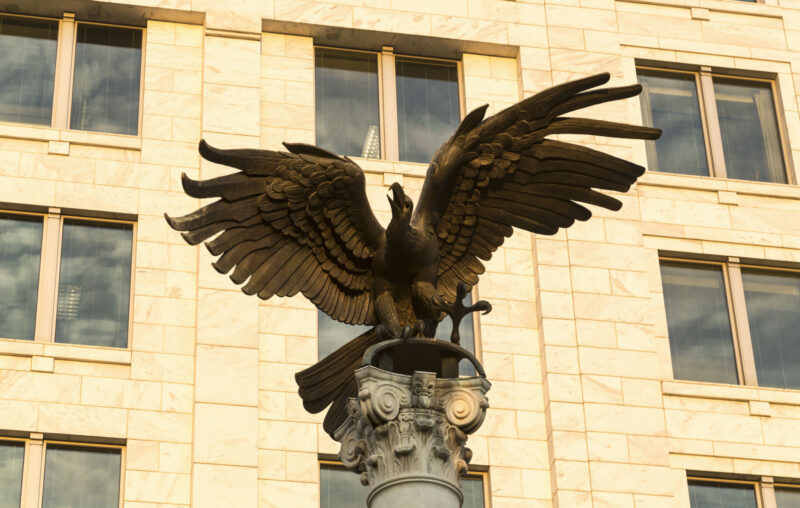The Federal Reserve Accountability Act in Light of 333 Years of American Experiments

Professor Nicolás Cachanosky argues that the amendment proposed in the Senate in December 2022 would have made the Federal Reserve more political. The amendment mainly proposed to change the appointment process for Federal Reserve Bank presidents. Instead of being elected by representatives of the local economy and appointees of the Board of Governors in Washington, they would be appointed by the President and confirmed by the Senate, just like Board members. As a result, the Federal Open Market Committee (FOMC) would be composed entirely of Senate-confirmed Presidential appointees.
I wish to add to Cachanosky’s correct assessment a historical perspective that goes beyond the history of the Fed, and even beyond that of the United States. The conclusion from four experiments in American central banking is that the concentration of power in Washington, DC may undermine the Fed’s very existence. Whether this is good or bad for the economy is another matter.
As revealed in my new book, the first open market committee in history was established in Massachusetts in 1690. During King William’s War, the colony paid soldiers by issuing the first paper money in the continental English colonies. The authority to issue was given to a committee that injected the new money into the economy by exchanging it for government debt instruments held by soldiers – an open market purchase. Hence, in retrospect, I call this long-forgotten committee the Massachusetts Open Market Committee (MOMC).
The MOMC included two members of the Council (executive), the Speaker of the House of Representatives, and two private men. All five were “merchants,” and thus the leading financial experts around. One was the colony’s treasurer and all others had recently participated in private banking ventures, although at that point no bank was in operation. The two private men were appointed as a check on the government’s power, protecting their fellow merchants, who were the lending class, from inflation. Every committee decision required the assent of three men. The three representatives of the executive and legislature could outvote the private sector, but only if there was a consensus among them. Remarkably, this holds today for the FOMC with almost the same ratios: seven members appointed and confirmed by the executive and legislature, and five members representing the private sector.
The MOMC did its job well and was imitated by other colonies. But it was gone and forgotten by the time the United States was founded. The imported structure of the Bank of England, a single private bank serving the government, proved to be inconsistent with the American notions of decentralization and checks and balances, leading to its political failure not once but twice. The First and Second Banks of the United States were each terminated by politicians after 20 years.
Lessons were learned in the creation of the world’s weirdest central bank: the Federal Reserve System. As created in 1913 it also gave most power to the private sector, but it was decentralized across 12 districts and was weakly supervised by a President-appointed, Senate-confirmed Board in Washington. This structure survived politically for 22 years, and was fundamentally modified following the Great Depression. In 1935 the 12-member FOMC was created in law, with the Board taking seven voting rights, leaving five to the Reserve Banks. The unconscious resurrection of the spirit of the 1690 MOMC served the Fed well in the sense of political survival: 88 years and counting, more than the three previous experiments combined.
The remarkable similarity of the 1935 FOMC to the 1690 MOMC is not a coincidence. Both are manifestations of checks and balances among the executive and legislative branches and the private sector. The role of the private sector in the American constitutional structure is a uniquely American feature that predates the United States. The jury system, the annual voting on public offices and legislative proposals, and the right to bear arms, continually empower the citizenry like in no other democracy. The private sector’s role in the Federal Reserve System, even if diminished since 1935, is part and parcel of this unique American experiment.
By making the Fed so much more controlled by Washington, and removing even the appearance of private-sector influence, the proposed amendment could fatally weaken the Fed’s political legitimacy. It can happen very quickly. Almost anyone can be appointed president of a Federal Reserve Bank. The amendment rightly requires residence and business in the relevant district and reduces the number of districts from twelve to five. The declared Republican goal of preventing “left-leaning political bias,” however, will not be advanced by transferring power now to the Democrat-controlled presidency and Senate. The latter could place in the FOMC the likes of Stephanie “MMT” Kelton (New York Fed), Rohan “Trillion-dollar coin” Grey (San Francisco Fed), and Beto O’Rourke (Dallas Fed).









